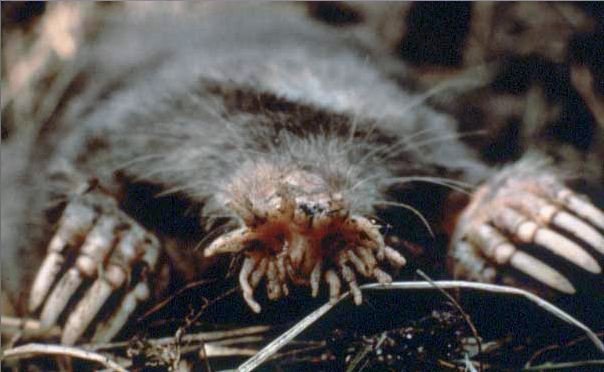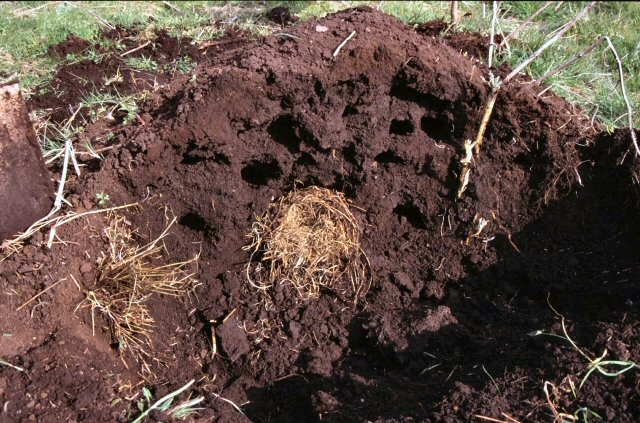Star-Nosed Mole: Condylura Cristata

Description Of The Star-Nosed Mole
One of the most distinctive mammal species is Condylura cristata. Its unique nose is hairless and is equipped with 22 pink star-shaped fleshy tentacles.
Condylura cristata ranges in total length from 175 to 205 mm and weighs between 35 and 75 g. The star-nosed mole has a stout, roughly cylindrical body with stocky forelimbs, broad feet, and large claws.
It has short, dense, and coarser hair. The fur on the back is dark brown to black, and the underneath is a lighter brown. The mole’s tail is 65 to 85 mm long, annealed, scaly, and covered with coarse hair, constricted at the base. The tail swells from 3 to 4 times its standard diameter during winter. 1Go To Source animaldiversity.org -“Condylura cristata star-nosed mole”
Learn More: Moles In Yard
Star-Nosed Mole Size
Measurements of the average-sized star-nosed mole:
- Length: 4.6 in
- Tail Length 2.8 in
- Height: 4.5 cm
- Weight: 1.7 oz
Behavior Of Star-Nosed Moles
Like many other moles, the star-nosed mole will dig extensive tunnel networks through moist soil. The tunnels typically are 3.3 to 7.6 cm wide and can extend up to 270 m along the edge of suitably wet habitats. The mole digs shallow surface tunnels for foraging but does not dig deeper for protection from winter weather. Only occasionally do the surface tunnels come close enough to the surface to cause an elevated ridge. The loose ground dug out of the tunnels is pushed to the surface, creating ‘molehills.’
Above the waterline in the tunnel system, a spherical nest is constructed, often beneath a log, and lined with dry leaves or grass. Condylura cristata is semiaquatic, unlike other North American moles, so many of its tunnels open under the surface of a stream or lake. The strong forelimbs also make good paddles, and with alternate strokes of both front and hind feet, it swims underwater, resulting in a zigzag motion.
This is the only mole species that use runways (often made by other small mammals) through meadows or marsh vegetation. Throughout the winter, star-nosed moles are active, burrowing through snow and even swimming under the ice of frozen ponds.
In a number of different activities, the star is used. When Condylura cristata burrows to prevent soil from entering the nose, the tentacles are held forward over the nostrils. While consuming prey, this behavior also happens.
The tentacles are used continuously during regular foraging activity to feel the mole’s surroundings, moving so quickly that they appear as a blur of motion, touching as many as 12 objects per second. Identification of prey can be done in less than half a second using these supersensitive organs. 2Go To Source biokids.umich.edu -“Star-nosed mole Condylura cristata”
Star-Nosed Mole Reproduction
Mating starts from mid-March to April, with offspring born in late April through mid-June. Like other moles, females produce one litter of offspring per year. Litters are born after a 45 day gestation period ranging in size from 2 to 7 (average 5) young.
At a rapid rate, the pale pink, blind, and hairless newborns grow. At 2 weeks, the star’s eyes, ears, and tentacles become functional, and the young are ready for weaning after 3 weeks. 3Go To Source tn.gov -“Star-nosed Mole, Condylura cristata”
Preferred Habitats Of The Star-Nosed Mole

Condylura cristata is the only semi-aquatic mole in the western hemisphere that prefers to live in riparian environments. A riparian climate is an area of land that lies next to a water body and has little capacity for drainage; this may be a river, lake, swamp, or any other water presence.
The features of this region are greatly affected by the surrounding water. The vegetation, the soil, and the water itself includes these affected areas. For the most part, the ground is extremely damp and is full of nutrients brought downstream by the body of water.
Although this is the normal homeland of Condylura cristata, they have also been seen in a variety of areas. In warm or cold environments and at many different elevations, they can survive happily, the lowest being the Atlantic coastline and the highest being the Great Smoky Mountains. In dry areas miles from a water body, these moles have also been seen sparingly, but this is not typical. 4Go To Source bioweb.uwlax.edu -“Habitat”
Star-Nosed Mole Range & Distribution
A native of eastern North America, the Star-nosed mole, is common within the United States and southeastern Canada resident. Its range extends westward to North Dakota and Manitoba from the Atlantic Ocean and south to Virginia and Ohio. It also occurs southwards to Georgia and throughout the Appalachian Mountains on the Atlantic coast. 5Go To Source animalia.bio -“STAR-NOSED MOLE”
Diet Of Star-Nosed Moles
This mole pushes its way through the soil’s surface layers to catch invertebrates such as beetle larvae and earthworms. However, star-nosed moles living near water acquire only 12-25% of their food in this way, taking the remainder underwater. With mollusks, crustaceans, small amphibians, and fish making up the rest, aquatic insects and annelids form the bulk of the diet.
The principal winter foods of star-nosed moles living near water are bottom-dwelling aquatic invertebrates. By examining bottom sediments with their fleshy tentacles laden with touch receptors, they easily enter the water, even swimming under the ice, foraging. 6Go To Source esf.edu -“Star-nosed Mole (Condylura cristata Linnaeus)”
Top Predators Of The Star-Nosed Mole
- Weasels
- Skunks
- Foxes
- Owls
- Minks
- Hawks
- Bullfrogs
Threats & Conservation Of The Star-Nosed Mole Species
There is little information available regarding the abundance and life history characteristics of the star-nosed mole. Because the species appears to be closely linked to moist habitats and friable soils, it is likely to be detrimental to land management practices that affect aquatic ecosystems through drainage, ditching, and conversion to agricultural or industrial uses.
As a result, the known geographical range appears to be fragmented, and the species is often absent from otherwise suitable habitats. 7Go To Source nrs.fs.fed.us -“Star-Nosed Mole Condylura cristata (Linnaeus, 1758)”
Sources:
- Zera, S. 2004. “Condylura cristata” (On-line), Animal Diversity Web. Accessed February 03, 2021 at https://animaldiversity.org/accounts/Condylura_cristata/
- Zera, S. 2004. “Condylura cristata” (On-line), Animal Diversity Web. Accessed February 03, 2021 at http://www.biokids.umich.edu/accounts/Condylura_cristata/
- “Star-Nosed Mole | Tennessee Wildlife Resources Agency.” Tennessee Wildlife Resources Agency, Tennessee Wildlife Resources Agency, www.tn.gov/twra/wildlife/mammals/small/star-nosed-mole.html. Accessed 3 Feb. 2021.
- “Star-Nosed Mole | Habitat.” University Of Wisconsin La Crosse, Template Design, bioweb.uwlax.edu/bio203/s2014/fisher_cody/habitat.htm. Accessed 3 Feb. 2021.
- “Star-Nosed Mole – Facts, Diet, Habitat & Pictures on Animalia.Bio.” Animalia, Animalia, animalia.bio/star-nosed-mole. Accessed 3 Feb. 2021.
- Saunders, D. A. “Star-Nosed Mole | Adirondack Ecological Center | SUNY ESF | College of Environmental Science and Forestry.” ESF SUNY College of Environmental Science and Forestry, State University of New York, 1988, www.esf.edu/aec/adks/mammals/starnosed_mole.htm.
- Laerm, Joshua, et al. “Star-Nosed Mole Condylura Cristata (Linnaeus, 1758).” USDA Forest Service, USDA, www.nrs.fs.fed.us/pubs/jrnl/2007/nrs_2007_laerm_011.pdf. Accessed 3 Feb. 2021.
